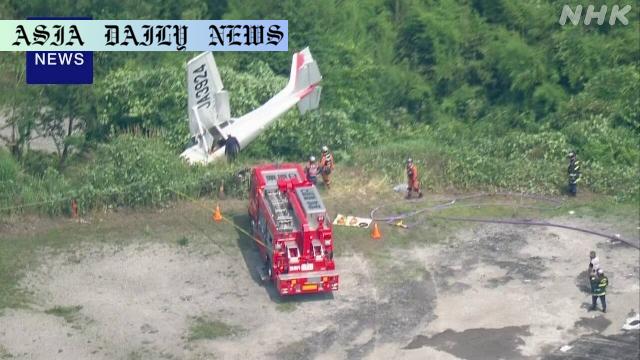Plane Incident: Emergency teams rescue two individuals after small plane overruns runway and falls off cliff in northeastern Japan.
Emergency services rescued two passengers from a small plane in Miyagi Prefecture.
The plane overran the runway and fell over a cliff at Semine Airfield.
Transport Safety Board deems this a serious incident and launches investigation.
A similar incident took place at the same airfield last October.

Plane Overruns Airfield Runway in Northeastern Japan
A small plane incident at Semine Airfield in Kurihara City, Miyagi Prefecture has raised concerns over aviation safety in the region. On Monday, the local fire department responded to a distress call about a small plane overrunning the runway and tumbling off the edge of a cliff. The plane, carrying two individuals, came to a halt precariously balanced amidst dense bushes near the cliff face. The threat of further descent added urgency to the rescue operation.
Rescue teams quickly extracted a man in his 70s and a woman in her 30s from the aircraft, both of whom were conscious and able to communicate. The duo was promptly transported to a nearby hospital for evaluation. No immediate reports of life-threatening injuries were disclosed, but the incident has drawn significant attention from local residents and aviation authorities alike.
History of Aviation Concerns at Semine Airfield
Remarkably, this wasn’t the first such mishap at Semine Airfield. Only a year ago, another plane encountered a similar fate, overshooting the runway and plunging over the same cliff. These repeated incidents suggest deeper issues at the airfield, warranting a comprehensive review of its infrastructure and operational protocols. The Transport Safety Board, which has labeled this event a serious incident, has deployed three investigators to analyze contributing factors and to prevent recurrence.
A Broader Reflection on Aviation Safety
This latest episode has sparked broader questions about aviation safety standards for small airfields across the region. Emergency responses were timely and professionally managed, yet the airfield’s setup and pilot operations are under scrutiny. Consistent and recurring failures indicate the necessity of stringent safety measures and thorough investigation to assess runway conditions, weather patterns, and pilot training processes. As Japan balances growth in aviation traffic with safety considerations, this particular region’s ongoing issues will likely remain in focus for years to come.



Commentary
Recurring Aviation Mishaps: A Cause for Concern
The recent small-plane incident in northeastern Japan is not just a random accident; it’s a striking reminder of the complexities involved in maintaining aviation safety, particularly in smaller airfields. With repeated anomalies at the Semine Airfield within a mere year, it’s imperative to address underlying structural and procedural inadequacies. Lives were at stake, and while swift emergency response prevented a tragedy, this should be seen as a wake-up call for aviation administrators and safety regulatory agencies.
Community and Stakeholder Accountability
The role of local authorities and stakeholders in ensuring airfield safety cannot be overstated. Apart from holding airlines and pilots accountable for appropriate operational practices, a spotlight should be cast on the physical and environmental limitations of runways like the one at Semine Airfield. Weather conditions, insufficient runway lengths, and improper systems to manage overrun incidents indicate broader systemic breakdowns rather than coincidental mishaps. The Transport Safety Board’s decision to investigate is reassuring but only scratches the surface of what appears to be a larger trend of negligence or oversight.
The Role of Public Awareness and Policy
Incidents like this also bring to light the important role of public awareness and media scrutiny. Local governments and aviation stakeholders must be transparent in disclosing findings and implementing preventative measures. The public deserves assurance that air travel is safe, even in regional and less trafficked zones. As Japan continues to rise as an international destination, these steps will be fundamental in reinforcing its reputation as a leader in safe and efficient transport industries.
The Semine Airfield incident is a stark reminder of the balance between human error, environmental unpredictability, and infrastructure reliability. Though no lives were lost, the incident underscores the need for diligence, responsiveness, and above all, a commitment to continuous improvement. Aviation safety must remain a top priority, echoing a sentiment that goes beyond immediate fixes and into a culture of proactive vigilance.